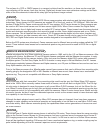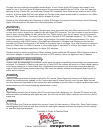
The surface of a CCD or CMOS sensor in a camera is shinier than film emulsion, so there can be more light
rays reflecting off the sensor, back thru the lens. Digital-only lenses have more extensive coatings on the back
sides of the lens elements to absorb this stray light and preserve image contrast.
CANON
In the late-1980s, Canon introduced the EOS 35mm camera system with autofocus and the latest electronic
technology. Canon lenses for EOS cameras are marked EF on the front, such as “EF 28-85mm”. With the intro-
duction of digital SLRs, Canon continues with the EF lens system. All EF-series lenses for 35mm cameras can
be used on all Canon small sensor and full-size sensor digital SLRs. When Canon created the Digital Rebel,
they introduced a line of digital-only lenses are called EF-S series lenses. These lenses have the same physical
mount and electronic coupling system, but cannot be used on older Canon digital cameras and on no Canon
35mm cameras. This is because the rear portion of EF-S lenses extends deeper into the mirror chamber and
damage to the mirror on older cameras can occur. Canon EF-S lenses should only be used on the Canon EOS
20D, 30D and Digital Rebel series and newer models designed to be compatible with EF-S lenses.
Before the EOS system was introduced, Canon cameras used a different lens mounting system called the “FD”
mount. These manual-focus lenses had a mechanical aperture ring and cannot be used on EOS film or digital
cameras.
MINOLTA MAXXUM/SONY ALPHA
Minolta introduced the first 35mm autofocus camera system in 1985, sold in the U.S. as Maxxum cameras. After
merging with Konica, the Maxxum 7D and 5D digital cameras continued with the Maxxum lens system. In early
2006, Konica Minolta left the camera industry. Sony took over the Maxxum digital SLR system and renamed it
the Alpha system. The first Sony Alpha, the A100 is similar in many ways to the last Maxxum, the 5D. Lenses
interchange completely between Maxxum and Alpha cameras, so a 20-year old Maxxum lens can be used on a
Sony Alpha camera, and vice versa.
Prior to the Maxxum camera line, Minolta made manual-focus cameras that used a different lens mounting style,
usually going by the designation MC or MD. Besides a different lens mount, these lenses has a mechanical
aperture ring. They are not compatible with Maxxum or Sony Alpha cameras.
NIKON
Nikon continues with their venerable F lens mounting style used from the very first Nikon 35mm SLR camera
back in the 1950s. Nikon currently makes three series of lenses, and all will work on digital SLRs. The DX digi-
tal-only series is designed to cover the sensor on all current Nikon D-SLR cameras, but not the 35mm film for-
mat. Nikon D-series lenses are for both film and digital cameras and have a mechanical aperture ring plus elec-
tronic aperture control for full compatibility with older film cameras. Nikon G-series lenses cover 35mm and digi-
tal sensor formats, but don’t have the mechanical aperture control so the camera needs to have electronic aper-
ture capability to use this lens type.
Although the basic physical mount used by Nikon SLR cameras has not changed, there have been numerous
changes to meter coupling and autofocus operation so functionality of an old lens on a new Nikon D-SLR cam-
era varies widely. Nikon camera manuals specify the capabilities when various generations of lenses are used
on a new camera.
PENTAX
The current line of Pentax digital camera lenses is called the DA series. These lenses have the same mounting
style as the Pentax K-mount lenses for 35mm cameras, but have a reduced area of coverage since Pentax D-
SLR imaging sensors are smaller than 35mm film. As a result, if a DA lens is used on a Pentax 35mm camera,
there will be significant vignetting. DA lenses don’t have a mechanical aperture ring, so meter coupling may be
quite limited depending on the film camera’s aperture control requirements.





